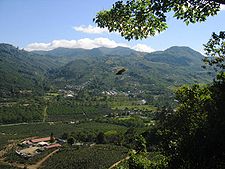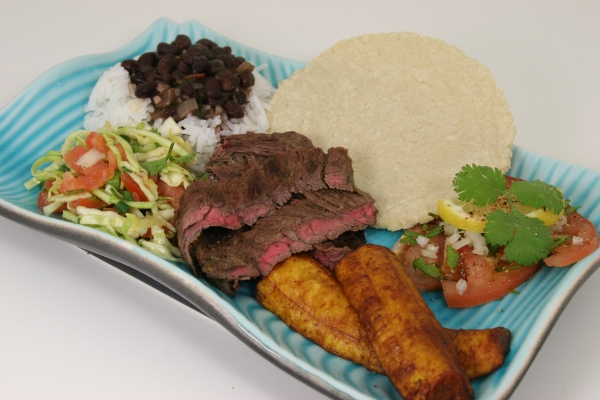 Rejoining the ship after several days we once again head across the Atlantic Ocean and into the Caribbean Sea. Our destination is the Central American mainland and the small nation of Costa Rica. I always feel that the name of this place should be pronounced: Costah RRRRReeeKah and preferably to the tune of a fast moving Calypso beat.
Rejoining the ship after several days we once again head across the Atlantic Ocean and into the Caribbean Sea. Our destination is the Central American mainland and the small nation of Costa Rica. I always feel that the name of this place should be pronounced: Costah RRRRReeeKah and preferably to the tune of a fast moving Calypso beat.
In a direct, about face from the trials of much of post colonial Africa, Costa Rica has a long and polished reputation as a safe, happy and carefully managed country. Although this is of course subjective, consider some of the facts about this unique country before you decide. Costa Rica took the unusual step of permanently abolishing its military in 1949. They rank 1st in the Americas in terms of the Human Development index, 3rd in the world overall, are rated the “Happiest Nation on Earth” and also the “greenest” and plan to be the first “Carbon Neutral” nation by 2021. Not a bad track record for a small country surrounded by troubled neighbors.
So what makes a country like Costa Rica stand out from so many of its neighbors? Is it unique philosophies, a more holistic approach to governance and daily life? Or is it the wisdom to observe the squandered opportunities of other places and the end result of such courses of action? To decipher the riddle perhaps a look into the past is appropriate.
Costa Rica, like so many Central and South American nations is a former Spanish Colony. Unlike most, it has developed in relative isolation. Far from the former Spanish Colonial capital in Guatemala City, little active interest in Costa Rica’s development was paid by the Spaniards. This isolation meant that Costa Rica started off poor and slow to develop. Another interesting side effect of this isolation was the lack of forced labor of its native people. In turn this reduced the class structure that is found through much of the rest of Latin America.
On September 15th 1821 the provinces of Central America declared independence from Spain and shortly thereafter formed the Federal Republic of Central America. The day of independence is still celebrated through most of Central America. This lasted until 1839 when Costa Rica formerly withdrew from the arrangement and formed an independent nation.
Although Costa Rica has seldom seen intense violence, from 1917-1919 the nation was ruled as a dictatorship by Federico Tinoco Granados. He was overthrown and forced into exile after only two years in power. Another uprising occurred in 1948 after a disputed presidential election. Jose Figueres Ferrer overthrew the government in a bloody 44 day civil war that was the bloodiest event in Costa Rica during the twentieth century. His next moves were nearly unprecedented. With power in their hands, the newly installed government abolished the army, wrote a constitution and relinquished power peacefully in favor of democratic elections. Ferrer went on to become the first president by popular vote and Costa Rica has enjoyed a relatively peaceful fair democratic existence ever since.

Perhaps this is why so many ex-patriates enjoy retirement in the tropical heat of Central America in beautiful Costa Rica? Perhaps the appeal is the coastlines in both the Atlantic and Pacific or the beautiful mountains that march through the center of the country? Maybe asking questions leads to more questions and real answers are seldom found? Thus is the life of an adventurer.
Costa Rica’s national dish is called Casado. In truth it is not one specific dish, but a plethora of options plated together forming a marriage of flavors and textures. In fact, Casado means “marriage” in Spanish. I was a bit nervous that this dish would wind up being a massive overbearing platter of protein and cholesterol like Bandeja Paisa in Colombia. Not that I mind lots of meat, but I also crave the freedom of fresh veggies and the tangy and heady aroma of cilantro, tomatoes and onions cut with the zest of citrus and pepper.
Casado is a dish found throughout Costa Rica and in time you would find yourself migrating to your favorite places and recipe combinations. When ordering Casado, you are given the selection of items that will appear on your plate as well as a choice of meat, usually chicken or beef. Traditionally, you would have your meat selection grilled or stewed with sides of a cabbage salad with sliced tomatoes, fresh corn tortillas (still hot!) Black Beans and rice or Gallo Pinto another Costa Rican classic with a side of fresh Platanos Maduros (Ripe Plantains) fried or baked. The aromas clash and dance in the air around your nose. The colors are vibrant and bold. The textures range from crunchy to smooth. They leave you feeling full but liberated, not bloated and slow. This is a meal worth exploring for a few months as every day and every place could be different. Maybe retirement in the peaceful nation of Costa Rica is the single smartest decision you could make if you love fresh food?
I give this dish a 3 for difficulty. Nothing is particularly challenging to make, however experience in blending the flavors of Central America are a plus. Leave time for the long soak method of cooking the beans or simply open a can and season the beans in their juices. Either way, prepare to truly enjoy this dish.
CLICK HERE FOR A PRINTER FRIENDLY VERSION
Rating:
Appearance: 4 out of 5 (loses one point for lack of a formal presentation)
Aroma: 5 out of 5
Flavor: 5 out of 5
Total: a whopping 14 out of 15!!
Ingredients:
3 Plantains (ripe)
3 Tomatoes
1 Large Onion
½ Green Cabbage
2 heads of Cilantro Chopped
1 Large Lemon
1 tsp Garlic Powder
3 cloves Garlic
1 large can Black Beans
1 cup Rice
1lb Flank Steak
Maseca Flour (corn tortilla flour)
Alino Marinade
Salt and Pepper (fresh ground)
Note: Prepare the component dishes in the order below for best timing. As each is resting or marinating, move on to the next step.
Preparation for Meat:
Marinate Steak in Alino marinade for 1 hour. Grill to medium and remove from heat. Allow to rest 5-10 minutes in a covered plate. Slice on the bias for delicious steak bites.
Preparation for Salad:
Slice cabbage to thin shavings. Squeeze ½ lemon over the cabbage. Add 1 cup tomatoes diced, ½ cup diced onions, ½ cup sliced scallions, 1 cup chopped cilantro, garlic powder and salt and pepper to taste. Stir and allow to rest in fridge for 1 hour.
Preparation for Black Beans and Rice:
Place unrinsed black beans in a saucepan bring to simmer or prepare dried beans according to package directions including an overnight soak.
Add ½ cup diced tomatoes, 3 diced cloves garlic, 1 handful of diced onion, handful of cilantro and pinch of salt and cracked pepper
Simmer for 20 mins to let flavors incorporate
Preparation for Rice:
Follow directions on package for 1 cup of rice.
A typical recipe calls for approximately 1.5 cups water with a pinch of salt. Bring to a boil then reduce to simmer for 18 mins. Remove from heat and allow to rest for 5-10 minutes.
Preparation for Tortillas:
Mix Maseca with a pinch of salt and water according to directions on package. Form 1” balls and flatten with a tortilla press or a plate till 1/16” thick. Gently fry in a lightly oiled pan till one side is cooked. Flip over the tortillas and press down with a papertowel as they puff up. Allow to finish cooking about 1-2 minutes per side. Store in a covered dish lined with a slightly damp towel to hold in heat and moisture. Serve hot.
Preparation for Plantains:
Peel ripe plantains. Fry in 350 Degree vegetable oil till dark golden brown. Remove to a paper towel lined tray to drain. Serve hot.
Serves 3-4


Eric Ackerson is a food writer, blogger and seafood marketing professional. His work takes him to many ports of call around the world. Currently Eric is cooking the national dish of every country on Earth at his blog My Hungry Tum. Eric enjoys travel and says his favorite food cities are Singapore and Vancouver. He lives in Charlotte NC with his wife and two daughters who he says are quickly becoming “foodies” themselves…








